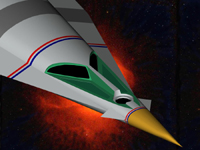 The nose, forward of the wide grey band, is all that was
ever designed of the exterior by the studio.
The nose, forward of the wide grey band, is all that was
ever designed of the exterior by the studio.
COLONEL GEORGE TAYLORS SPARROW
IIIC: ICARUS
Computer Generated Images and plans
The following are a collection of images based on a 3D model built in the mechanical design software called SolidWorks. Admittedly I was in a hurry and should have used an "assembly view" so that the escape hatch could be included but I just wanted something to give an idea what the design looked like. I may go back later and recreate these images using the assembly view and a model complete with "decal" markings but for now this will have to do. After creating the initial image, the files were then opened in PhotoShop where additional elements were added such as weathering, surface glow and smoke. The hardest thing about creating these images is the matching of the model lighting with the background images. This was done with varying degrees of success as you will see. The background images came from a NASA web site that features images of the Earth taken by various Space Shuttle missions and in some cases, the images have been squeezed along the Y axis to create a feeling of lower altitude. Click on the thumbnail images to open the larger file.
(Images files are approximately 100K to 200K in size)
 The nose, forward of the wide grey band, is all that was
ever designed of the exterior by the studio.
The nose, forward of the wide grey band, is all that was
ever designed of the exterior by the studio.
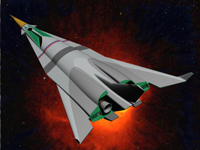 The Icarus aft fuselage as designed by Phil Broad...
The Icarus aft fuselage as designed by Phil Broad...
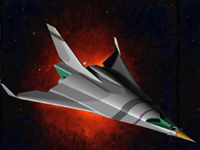 The Sparrow IIIC variant features a highly swept delta wing
design optimized for re-entry speeds.
The Sparrow IIIC variant features a highly swept delta wing
design optimized for re-entry speeds.
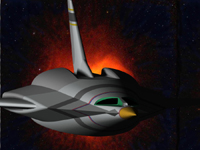 At approximately 100 feet in length, the aft area provides
ample space for stowage of basic exploration equipment.
At approximately 100 feet in length, the aft area provides
ample space for stowage of basic exploration equipment.
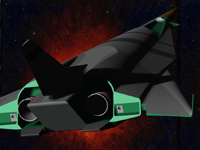 The flat chisel-shaped surface between the exhaust bells
features a drop down cargo ramp for the deployment of exploration equipment
after landing.
The flat chisel-shaped surface between the exhaust bells
features a drop down cargo ramp for the deployment of exploration equipment
after landing.
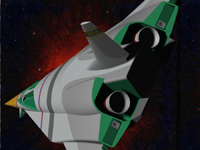 Taylors ship is propelled over interstellar distances by
a huge robot transport which mates to this craft via the interface receptacles
(seen outboard of each engine).
Taylors ship is propelled over interstellar distances by
a huge robot transport which mates to this craft via the interface receptacles
(seen outboard of each engine).
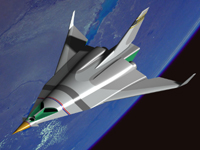 After separating from the automated transport section the
Sparrows onboard computers begin the de-orbit manuevers in preparation
for landing.
After separating from the automated transport section the
Sparrows onboard computers begin the de-orbit manuevers in preparation
for landing.
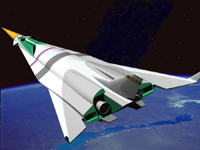 Once in postion the engines fire slowing the craft and causing
it to begin descent.
Once in postion the engines fire slowing the craft and causing
it to begin descent.
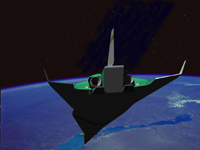 The computers swing the ship around until the nose is pointing
forward and now it is ready for re-entry.
The computers swing the ship around until the nose is pointing
forward and now it is ready for re-entry.
The ship drops belly-first through the atmosphere towards
a forbidding desert landscape below.
The Sparrow IIIC levels out at 40,000 feet and will select
a final landing area based on radar mapped data provided by the systems
onboard the larger robot transport.
The craft banks over the dead sea it will land near if all
goes well...
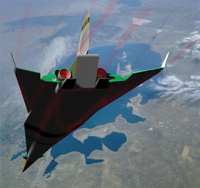 MALFUNCTION! Taylors fully
automated ship begins to experience main bus drop-out and intermitent computer
reboot.
MALFUNCTION! Taylors fully
automated ship begins to experience main bus drop-out and intermitent computer
reboot.
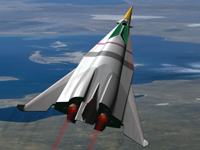 Each time the computer guidance system comes back on-line
it tries to regain height by firing the engines but it is no use, the crippled
ship will be lucky to hit the dead sea in the distance and not the desert
floor...
Each time the computer guidance system comes back on-line
it tries to regain height by firing the engines but it is no use, the crippled
ship will be lucky to hit the dead sea in the distance and not the desert
floor...